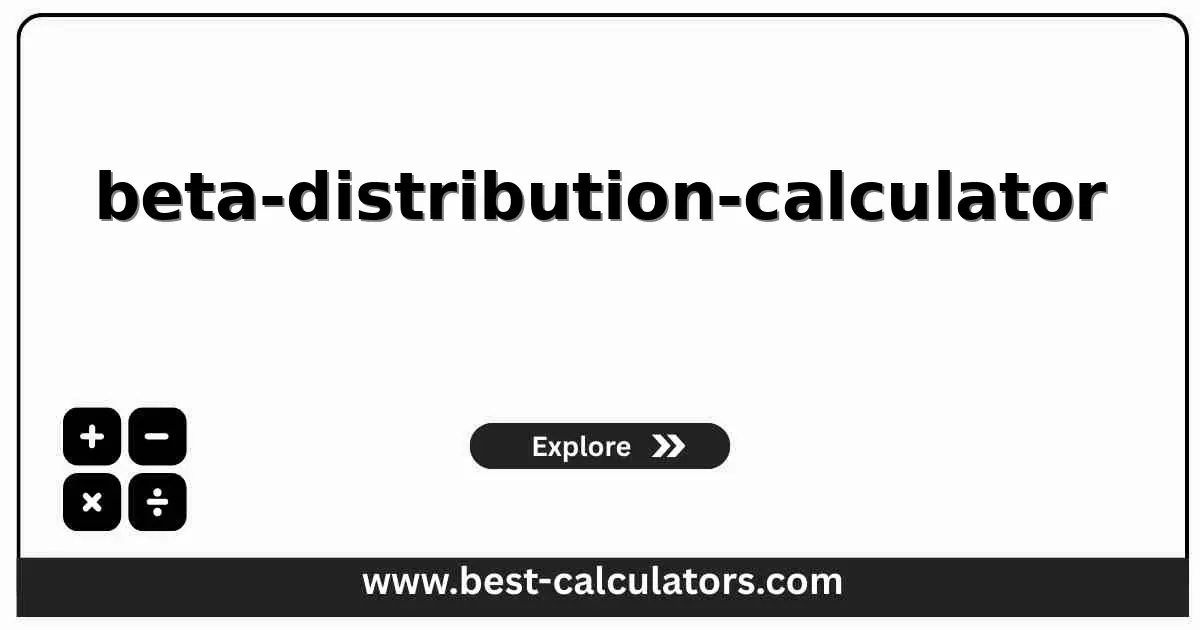Beta Distribution Calculator - Calculate Distribution Statistics
Calculate mean, variance, mode, standard deviation, and key statistics for Beta distribution using alpha and beta parameters
Beta Distribution Parameters
Distribution Statistics
What is a Beta Distribution Calculator?
A Beta Distribution Calculator computes statistical properties of the Beta probability distribution, including mean, variance, mode, and standard deviation based on two shape parameters α and β.
This calculator is used for:
- Bayesian Statistics - Prior and posterior probability distributions
- Project Management - PERT analysis for task duration estimation
- Quality Control - Modeling proportions and success rates
- Risk Analysis - Uncertainty quantification between 0 and 1
To understand discrete probability distributions, explore our Binomial Distribution Calculator to calculate probabilities for binary outcomes over multiple trials.
To work with continuous probability for time-based events, check out our Exponential Distribution Calculator to model waiting times and decay processes.
To estimate population parameters with uncertainty, visit our Confidence Interval Calculator to determine ranges for means and proportions in Bayesian analysis.
To understand how sample distributions approach normality, use our Central Limit Theorem Calculator to visualize sampling distribution behavior.
How Beta Distribution Works
The Beta distribution uses these formulas:
Where:
- α (alpha) = First shape parameter (> 0)
- β (beta) = Second shape parameter (> 0)
- Range = [0, 1]
Key Concepts Explained
Shape Parameters
α and β control the distribution's shape. Higher values concentrate the distribution; lower values spread it toward the boundaries.
Special Cases
When α = β = 1, Beta becomes uniform. When α = β, the distribution is symmetric around 0.5.
Skewness
Positive skewness indicates a right tail; negative indicates a left tail. Calculated as: 2(β-α)√(α+β+1) / ((α+β+2)√(αβ)).
How to Use This Calculator
Enter Alpha (α)
Input the first shape parameter (must be positive)
Enter Beta (β)
Input the second shape parameter (must be positive)
View Statistics
Review mean, variance, standard deviation, mode, and skewness
Benefits of This Calculator
- Instant Calculations - Get all statistics immediately
- Accurate Formulas - Uses standard statistical formulas
- Complete Results - Mean, variance, mode, skewness
- Academic Use - Perfect for statistics students and researchers
- Professional Tool - Suitable for Bayesian analysis and PERT
- Free Access - No registration or software required
Factors Affecting Distribution
- Parameter Values - α and β must both be positive
- Symmetry - When α = β, distribution is symmetric
- Concentration - Higher values create tighter distributions
- Boundary Behavior - Low parameters push mass toward 0 or 1
- Mode Existence - Mode requires both α, β > 1
- Uniform Case - α = β = 1 creates uniform distribution

Frequently Asked Questions
What is a Beta distribution?
The Beta distribution is a continuous probability distribution defined on the interval [0, 1] with two shape parameters, α (alpha) and β (beta). It's commonly used in Bayesian statistics and to model probabilities and proportions.
What are the parameters of Beta distribution?
The Beta distribution has two positive shape parameters: α (alpha) and β (beta). Both must be greater than 0. These parameters control the shape, center, and spread of the distribution.
What is the mean of a Beta distribution?
The mean of a Beta distribution is calculated as: Mean = α / (α + β), where α and β are the shape parameters.
What is the variance of a Beta distribution?
The variance of a Beta distribution is: Variance = (α × β) / ((α + β)² × (α + β + 1)).
When is Beta distribution used?
Beta distribution is used for modeling probabilities, proportions, percentages, Bayesian analysis, project management (PERT), quality control, and any random variable bounded between 0 and 1.
What is the mode of a Beta distribution?
For α > 1 and β > 1, the mode is (α - 1) / (α + β - 2). If α = β = 1, the distribution is uniform. If α or β ≤ 1, the mode may be at the boundaries (0 or 1).